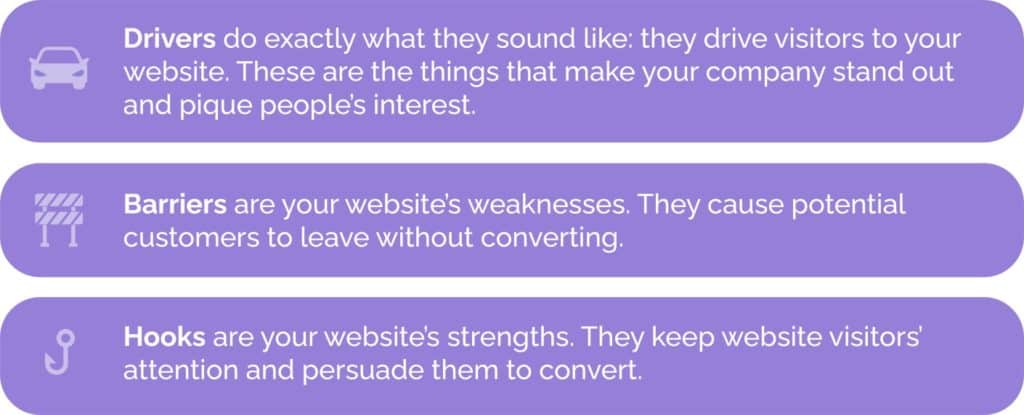We talk a lot about how important your website is.
Whether we’re talking about B2B web design or what type of content to include on your website, it’s clear that your website is the single most important piece of owned media that a business has.
It’s the place your customers come to learn more about your brand, the place where you have 100% control of the messaging, look, feel, and story, and the place where many prospects will convert and become customers.
And that is where CRO comes into play.
CRO stands for Conversion Rate Optimization. A CRO strategy is a plan meant to improve the conversion rate of a website. The goal is to convert more website visitors into customers by analyzing a website’s strengths and weaknesses. These are known as drivers, barriers, and hooks.
Let’s jump right in, shall we?
Drivers
Drivers do exactly what they sound like: they drive visitors to your website. These are the things that make your company stand out and pique people’s interest.
Barriers
Barriers are your website’s weaknesses. They cause potential customers to leave without converting.
Hooks
Hooks are your website’s strengths. They keep website visitors’ attention and persuade them to convert.

By assessing your site’s drivers, barriers, and hooks, you can make adjustments to reduce barriers and align your drivers and hooks to make sure that what you promise (your drivers that get prospects to the site) is what you deliver on (your hooks—or the content on your site that ties back to the content that brought them to your site to begin with).
The best strategies are based in hard data, and that means testing, gathering data, and analyzing the results—this is how a CRO strategy can grow into conversion rate optimization success.
Think of your CRO strategy as a science experiment—but without the safety goggles and beakers. Based on the data you collect, you will hypothesize what it is that your website needs to change. Then the fun part begins: you will test these ideas and watch results bubble up before your eyes.
Let’s look at a basic CRO template that outlines the phases of a strong CRO plan.
The Phases of a Strong CRO Plan
The Investigation Phase
Step one of any good CRO plan is to look at the existing data and use it to inform your next steps. We call this the Investigation Phase.
During this phase, you need to clearly identify your audience. What types of businesses are looking to work with you? What industries are they in, and what are their demographics?
When in doubt, ask your clients what they are looking for. Or, take a look at the trends you see in your data. Some CRO tips for the investigation phase include:
- Conducting Surveys: Surveys can give you insights into why your existing customers are purchasing your products. Create a survey that asks businesses what their experience was like and why they decided to work with your company. You can also ask them for general feedback, which can be harder to organize and quantify but gives them an opportunity to provide additional insights that you never thought to ask about.
- Using Google Analytics: Google Analytics is a go-to program of marketers everywhere because it helps you understand how your customers get to your website and their behaviors while on your website. This can help you determine which drivers and hooks are working and which aren’t.
- Look at Heatmaps: Heatmaps offer a visual representation of how your audience interacts with each section of your website. These color-coded maps can tell your business which pages have the most engagement. They also highlight where visitors drop off and closeout, which can help you identify and reduce barriers.
After careful research and feedback, it’s time to do some research.
The Research Phase
You’ve figured out what the existing data says—now it’s time to do some research. The first part of the research phase is understanding your goals.
Some questions to ask include:
- What are your website’s goals?
- What does the primary conversion funnel look like currently?
- What does success look like for your brand?
Once you clearly understand your brand’s personal goals for its website, you can determine KPIs for your CRO strategy. Key performance indicators will help you track your progress against the goals you identified, ensuring that the strategy adjustments you make are, in fact, creating real change and driving success for your business.
While the ultimate goal of a CRO is to increase conversions, you may have other specific goals arise based on the research you perform. For instance, you may find that customers are converting to buy one of your products, but are going to outside businesses for add-on products, so your goal may be about increasing repeat customers or driving sales for underperforming products. Other goals may include reducing shopping cart abandonment or increasing order value.
During the research phase, you will be looking at the data gathered during your investigation, discussing and determining your goals, and identifying how to get from point A to point B. Some of the activities that take place during research include:
- Developing detailed audience segments and determining your audience’s pain points
- Comparing behavior across the conversion funnel for your main segments
- Understanding your current user flow and conversion funnel
- Looking at your top acquisition channels
- Looking at your website’s performance (hosting and speed)
- Analyzing your conversion rate as compared to the industry average
- Comparing conversion rates over a variety of time frames to determine key performance times
- Reviewing brand messaging and identifying if the messaging hits on audience pain points
- Performing a content analysis to see if the content currently on your site is in alignment with your brand’s overall goals and messaging
- Implementing and monitoring a Heatmap that can be compared to the heatmap reviewed in the Investigation Phase
After spending a month or so doing thorough research, you should have a good understanding of your barriers and how to overcome them. You should also know which drivers are bringing prospects to your website and through which channels as well as which hooks are keeping users on your site longer and improving conversion, and which are falling short.
Now it’s time for the O in your CRO plan: Optimization.
The Optimization Phase
The optimization phase could also be called the experiment phase because, like the scientific method, in this phase, you create a hypothesis based on the data and research you gathered, and you test it by putting it into action.
Whether the website updates you recommend have to do with the design, the content, or the traffic routing strategy, each adjustment must be tracked and tested. Here are some testing strategies that will help you determine what works and what falls flat.
A/B Testing allows you to show your customers two different versions of your website. For instance, you can show the user your current site and compare it with a version that has an updated headline or a different color scheme. You should base your tests on one variable at a time. That way, you can easily determine the impact of each specific change and focus on eliminating barriers.
A/B testing can be specifically helpful when determining layouts and functionality. For instance, you can A/B test a landing page layout to see which is more successful. One sample landing page could include a navigation bar at the top, while the other could have a scroll-down feature. Once both versions of the site are live, A/B tests begin running to see which layout is more successful at engaging customers.
Multivariate Testing experiments with multiple variables at the same time. Think of this process as a more complex A/B test. These tests can save time by analyzing your hooks and barriers simultaneously, but they can be more confusing to read since you will have to take each variable into consideration.
Both of these types of tests have pros and cons. According to A/B Tasty, 90% of cases call for an A/B test rather than a multivariate one. This is due to the specificity of information. However, regardless of the type of test used, the most important component of a test is a strong hypothesis. Your hypotheses should be based in data from the research you performed. This will ensure that you’re making strong hypotheses that will bear definitive results.
The Implementation Phase
Congrats! You made it to the final phase of our CRO template: Implementation. In this final phase, you should have data from the testing you did in the Optimization Phase that will help you determine which adjustments worked and which didn’t.
The goal, in implementation, is to make sure that each idea presented in the optimization phase was thoroughly tested so that you can determine the optimal design for your website, make any updates, and track your new website against the KPIs and goals set in the earlier stages.
If each phase was performed thoroughly, you should see better conversations along with any other sub-goals you are targeting. If you find that this isn’t the case, don’t panic. Give it time.
Ideally, the adjustments to your website will reap immediate results, but that isn’t always the case. Depending on the industry, your audience segments, and even the time of year, you may need to give your updated website a few weeks or even a few months to see the positive results you desire.
If, at the few-month mark you are still lacking improvement, go back to the optimization phase and start testing. It’s possible that there is a variable that you overlooked, which will unlock your strategy.
Quick Tips To Boosting Your B2B CRO
Truth be told, to get real conversion rate optimization, you need to go through the whole process.
But if you need a jumping-off point to get some quick results and maybe even some quick wins, these are a few key places we look when investigating missed opportunities for conversion.
Call To Actions: Call To Actions (CTAs) tell visitors what you want them to do and how to do it. Websites that convert not only lead the horse to water, they tell that horse to drink! Check out your website and make sure that you are using clear and concise CTAs throughout your site.
At Zen Media, we place CTAs throughout all of our website’s pages. Perhaps the most important one is our “Let’s Talk” button placed to the right of our navigation bar. Its large font and bright purple border stand out and persuade our visitors to reach out to us.
Improve Load Times: Data suggests that load times affect businesses’ conversions and, ultimately, their ROI. A report by Neil Patel claims that a “1-second delay in page response can result in a 7% reduction in conversions.” If a website takes more than 3 seconds to fully load, 40% of users will close out the tab. Luckily, there are ways to improve a slow site.
Google offers free tools to measure your website’s load times. PageSpeed Insights is a great resource for businesses to understand their content’s performance.
Keep It Concise: A large paragraph of text (the dreaded text wall) is a common CRO barrier that will stop website visitors right in their tracks. Most of the time, they won’t even read your copy if it appears in a text wall. B2B transactions are most successful when they are done quickly and efficiently. So, cut the filler text and get down to specifics on what you are offering.
For B2B SEO purposes, make sure to focus on your important keywords— these are the words and phrases that your audience will search for when looking for services in your industry. Use these keywords to optimize your content for search engines. If businesses are able to find you on the first page of Google, your CRO rates will likely increase.
Why does your B2B Company Need a CRO Strategy?
B2C companies are all about CRO strategies. Their goal is to make customers convert as soon as possible—ideally on a user’s first visit.
Many B2Bs note that the longer sale cycle makes CRO strategies less relevant in B2B since immediate conversion is so unlikely.
But that’s exactly why B2Bs need a strong CRO plan.
For B2B companies, the stakes are higher when it comes to converting new leads, and any delay in the process can mean losing out to a competitor with a stronger website or share of voice.
The first impression can make or break a sale—even when the sales cycle is several weeks or even months long. This is why these CRO strategies are so important for B2B.
Need help setting up a conversion rate optimization strategy for your brand? We can help.





